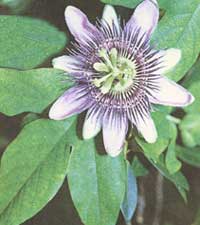Passionflower / passiflora
Refers to the family of passionate. Homeland - South America, Asia, Australia.
General description: Passionflower is an ampel fast growing plant with beautiful, but short-lived colors.
Usually in a room conditions a pair of the kind of passionflowers is bred:
Passiflora caerulea (Passiflora blue) Strong climbing liana with palmate-dissected leaves up to 10 cm long. On the stems in the axils of the leaves are located antennae, with which the passionflower is attached to the support. Blooms in the summer single colorful and fragrant flowers 8-10 cm in diameter. On the premises of flowers, orange egg-shaped berries ripen up to 6 cm in length.
Passiflora trifasciata (Passiflora three-strand) has a ribbed stem and mottled three-lobed leaves with silvery purple veins. The reverse side of the sheet is red-violet. Flowers and berries are smaller than the previous species.
Recommendations for caring for the plant Passiflora:
Illumination : photophilous, shading is needed only in the summer noon.
Irrigation regime : Abundant during the growth period, in winter unusual.
Humidity : Needs regular spraying, but not in direct sunlight.
Temperatures : Moderate, optimally 18-24 ° C, cool in winter 13-16 ° C. Without a cool period of inactivity of passionflower, winter usually does not survive or its appearance becomes extremely unattractive.
Soil : Proper benign drainage is required. You can add small gravel or expanded clay.
Recommended soil mix: 1 share of sod, 1 share of leaf, 1 share of peat land and 1 share of sand.
During the growth period, it needs fertilizing once every 2 weeks with fertilizer for flowering plants in half.
Breeding : Seeds and stem cuttings.
Transplant : Every year in the spring.
Pests : It is affected by scarlet spider mites (in a dry atmosphere, leaves and stems are braided with cobwebs), aphids (form sticky excretions on shoot tips, buds), scabbards (brown plaques appear on leaves and stems, leaving sticky discharge).
With a slight infection, the plant is allowed to help finish with a soap solution and a warm wash.
In case of severe damage, spraying with an insecticide solution (acticle, decis, phytoverm etc.) is recommended.

Passiflora blue - passiflora caerulea
Passiflora trilobite - passiflora trifasciata


Comments
When commenting on, remember that the content and tone of your message can hurt the feelings of real people, show respect and tolerance to your interlocutors even if you do not share their opinion, your behavior in the conditions of freedom of expression and anonymity provided by the Internet, changes Not only virtual, but also the real world. All comments are hidden from the index, spam is controlled.